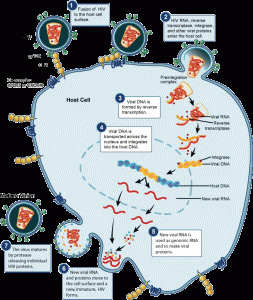
A painting at the U.N. shows a condom over the world to limit the spread of HIV/AIDS. But what if we could find a longer-lasting, more reliable topical treatment? (Photo: Island Nimbus/Flickr)
This month marks an anniversary that no one wants to see: 30 years since the first paper describing what we know now as HIV/AIDS.
Over those three decades, more than 30 million people worldwide have died from the disease. We have learned a great deal – how HIV is passed from person to person, how long it circulated among humans before it was recognized, how to control it with antiretroviral drugs. Yet HIV still spreads: An additional 2.6 million people were infected with it in 2009 alone. Safe sex practices like condom use provide an effective barrier against passage of the virus, but don’t affect HIV’s ability to gain a foothold should the barrier fail.
Judy Lieberman and Lee Adam Wheeler want to move prevention beyond one-time physical blockades to longer-lasting, more reliable molecular resistance. “The current model of HIV transmission holds that the virus is localized to the genital tract for about a week,” says Lieberman, “which could provide a window of opportunity to intervene and prevent the infection from establishing itself throughout the body.”
Last month the two researchers, from the Immune Disease Institute and the Program in Cellular and Molecular Medicine at Children’s, described a microbicidal barrier they developed that takes advantage of the biology of HIV transmission. The barrier relies on RNA interference (RNAi), a molecular phenomenon first discovered in plants in which genes are silenced by bits of RNA with complementary sequences, called small interfering RNAs (siRNAs).

The replication cycle of HIV. Judy Lieberman and Adam Wheeler want to stop the virus at the earliest step. Click to enlarge. (Image: NIAID)
In their study, Wheeler and Lieberman harnessed RNAi to turn off two HIV genes, gag and vif, as well as the gene for one of HIV’s two receptors, CCR5, in the host’s T cells and macrophages. And to make sure these siRNAs got to the right cells in the right tissues at the right time, Lieberman and Wheeler fused them to a second, specialized piece of RNA called an aptamer. The aptamer plugs into CD4 (HIV’s other co-receptor on the surface of T cells) like a key in a lock, granting the siRNAs entry into the cells.
This “fusion” strategy overcomes one of the greatest challenges in the therapeutic use of RNAi – delivery – and allows the siRNAs to get into the immune cells without compromising the overall immune response. The fused RNAs are also amenable to topical application, a route that has already shown promise in Lieberman’s lab for preventing herpes transmission.
“Last year it was shown that it is possible to prevent HIV transmission, at least to some extent, with a topical vaginal agent using an antiviral drug,” Lieberman says, “thus providing proof-of-principle that a topical strategy could interfere with virus transmission.”
The fusions worked quite well in living mice engineered with human immune systems. The researchers exposed the mice to HIV through the vaginal route, mimicking sexual transmission. Three months later, the fusion-treated mice were virus-free, while all of the mice that received a sham treatment had developed full-blown HIV infections.
The combination of RNAi to shut down genes, aptamers to target the right cells, and topical application form a potentially long-lasting way of barring HIV entry into the immune system, bolstering the public health arsenal against HIV/AIDS.
“The problem with most topical methods for preventing sexual transmission of disease is that you have to use them just before having sex, and compliance is a huge issue,” Lieberman says. “But our laboratory results show that we can knock down CCR5 expression potentially for weeks, suggesting that we could create a stable viral-resistant state where one would only have to apply the agent every couple of weeks.”
And in real world use, the system’s utility may not be limited to just one virus at a time. “Conceivably, one could include siRNAs against multiple viral agents in a cocktail to gain protection from multiple sexually transmitted diseases, including HSV and human papillomavirus.”







